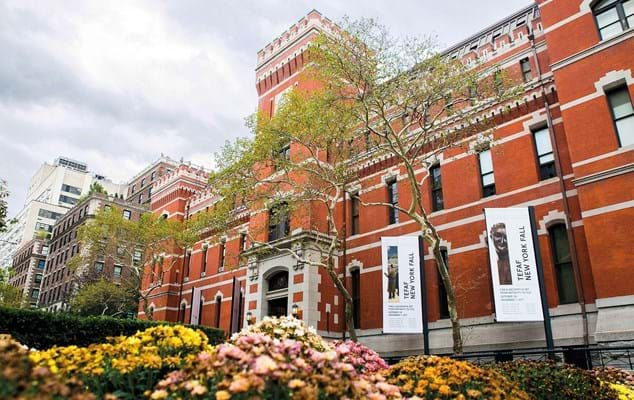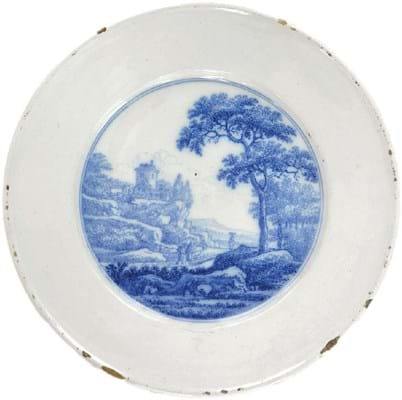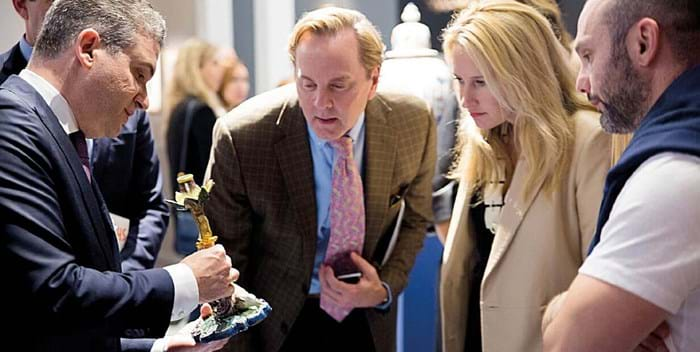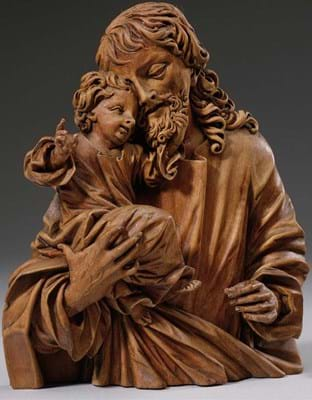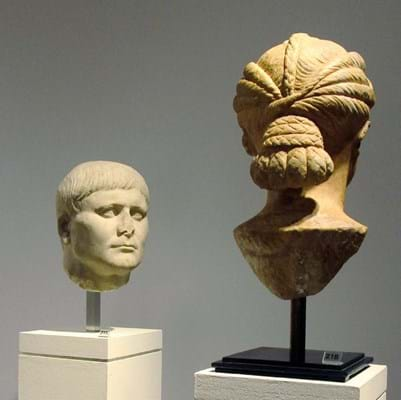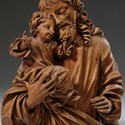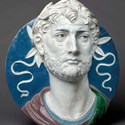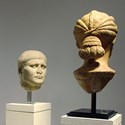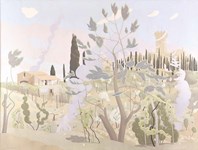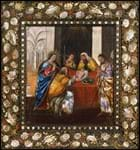For the second year, TEFAF New York Fall turned the Park Avenue Armory into a veritable museum for six days. From October 28-November 1 nearly 100 dealers presented the best they could muster and sales were made. Already it feels like the fair is carving out a niche.
Connoisseurs stand out in the crowd at TEFAF as they did at Haughton Fairs’ international show – the long-running event it replaced last year. They walk slowly, look carefully and engage in long conversation. Sometimes they buy.
“Museums take their time to make decisions; collectors are the buyers during the show,” said Tony Blumka, a fourth-generation New York dealer specialising in medieval, Renaissance and baroque works of art.
He shared a stand on the Armory’s second floor with two German colleagues: Julius Bohler of Starnberg and Georg Laue of Munich. “I wonder if everyone knows there is an elevator to get up here,” worried Blumka on the opening night.
The second floor is rarely used for other Armory fairs. Ascending the steep flight of stairs, and arriving in front of a bar with the words ‘Champagne, Salmon, Oysters’ spelled out on the wall behind it was, arguably, the best way to begin the TEFAF experience.
The high life
Collectors did find their way up there and the dozen well-known dealers with stands they found made sales.
Blumka sold a 15th century Nottingham alabaster relief of the Crucifixion, with traces of old paint and gilding, and Laue sold a small, unframed oil on panel of Christ in the Garden of Gethsemane from the Upper Rhine, c.1470-80. Bohler made multiple sales from his Wunderkammer and its accompanying catalogue.
Tom Postema, the TEFAF Maastricht designer, succeeded in transforming the huge drill hall downstairs into an elegant promenade of galleries.
“ We had our best start of any fair we’ve done in the US, and sales continued to be strong over the next few days
Martin Clist Director, Charles Ede
Using tall white posts capped by a continuously lit cornice and glass chandeliers filled with flowers, he provided a serene space to view some of the finest traditional art and antiques on the market in October.
The crowd at the VIP opening on Friday from 2-9pm was larger than last year and it swelled at 6pm with the arrival of patrons of the cancer centre Memorial Sloan Kettering for its opening night benefit. The number of daily walk-ins seemed slim, but then a ticket for the uninvited did cost $65.
Old Masters and antiquities dominated – although the trend is undoubtedly towards those images or idols that fit well with the modern aesthetic. On Friday afternoon red dots appeared on the labels of three Cycladic idols on three different stands.
Charles Ede sold several works for six-figure sums across the fair, including a New Kingdom steatite Naophoros statue with an asking price of $350,000 to a young collector within the first few hours. Ede director Martin Clist noted: “We had our best start of any fair we’ve done in the US, and sales continued to be strong over the next few days. The attendees in New York have a high degree of sophistication.”
“ Museums take their time to make decisions; collectors are the buyers during the show
Tony Blumka New York dealer
Provenance is the hot topic in the antiquities field, in the US market as in others: fellow London dealer Rupert Wace had a limestone relief fragment from Persepolis seized from his stand pending investigation (see ATG No 2316).
With Christie’s Fall Classics series running almost concurrently with TEFAF, more Old Master paintings and sculpture sold than any other category at the fair.
One of the star sales of the fair was made by Carlo Orsi – Trinity Fine Art which sold a plaster copy of Anthony Canova’s (1757-1822) Rezzonico Genio, 1793, believed to be the only work of its kind on the market, for an asking price of $4m.
New to TEFAF, Robert Simon Fine Art sold three Italian 16th-17th century works including Portrait of Don Antonio de’ Medici by Alessandro Allori (1535-1607), a version of which also resides in the Fogg Art Museum in Cambridge, Massachusetts.
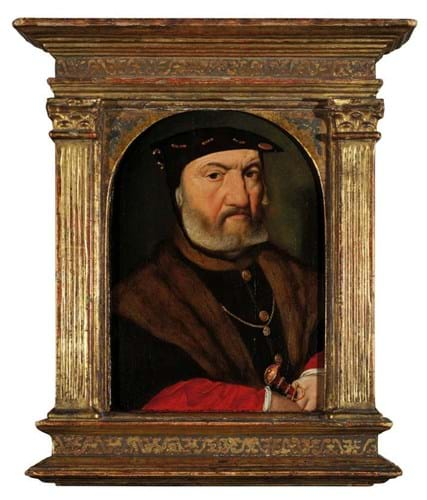
A small bust-length oil on oak panel portrait of a bearded man by Joos van der Beke, called van Cleve, c.1515-17, priced at $950,000 from Rob Smeets, Geneva.
Facial recognition
Portraits gazed across the fair. There were Greek and Roman marble faces, a glazed terracotta by Andrea della Robbia and Deruta chargers, while Elie Nadelman’s American heads in wood and marble brought the tradition into the 20th century.
Snapped up quickly was Ottavio Leoni’s small Conversation Piece on the stand of Galleria Carlo Virgilio & Co, Rome. The buyer got nine oil portraits of women on a 12 x 15in (30 x 39cm) copper panel in a carved baroque frame by the most fashionable artist in Rome in the first quarter of the 17th century.
Works of this quality do stay in the mind’s eye. Among the smallest items on show was a medieval bejewelled and enamelled hat badge at Galerie J Kugel, Paris, illustrating the story of the sacrifice of Isaac, and the array of 18th century Dutch silver ‘toys’ sold by Aardewerk, Amsterdam.
Emiel and Esther Aardewerk furnished a miniature gazebo or tea house, a replica of one built in 1672 in the garden of the mansion at 546 Herengracht in Amsterdam (now the Waldorf Astoria Hotel). The price was €95,000.
Other show-stoppers included a 6in (15cm) Elizabethan silver-gilt table salt c.1575 offered by Shrubsole, New York, and Tiffany Lotus pattern lamp at Lillian Nassau. Priced at $750 in Tiffany’s 1906 catalogue, the most expensive lamp Tiffany offered at the time, it had a seven-figure price tag at TEFAF NY Fall 2017.
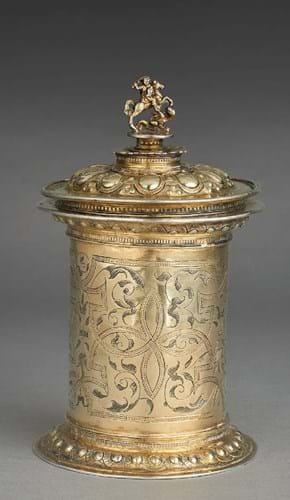
An Elizabeth I silver-gilt salt, East Anglia, c.1575, with George and the Dragon, engraved with initials MB/MW inside the well. From Shrubsole, New York.
Heavens in hand
The blue geographical map of the everlasting United Qing Empire at Daniel Crouch, London and New York, filled the wall behind his collection of 18th century pocket globes in shagreen cases, and was priced at $330,000.
“Not until the mobile phone and the advent of Google Earth would there be an instrument that so neatly epitomised the globe and the heavens in the palm of your hand,” wrote Crouch in his catalogue for the collection.
TEFAF New York now has a firm place on the Park Avenue Armory calendar, yet the feeling is it poses little threat to TEFAF Maastricht (March 8-18). Nothing compares to the 270-dealer spectacle in the Netherlands where 5000 guests are expected on the first day and 70,000 by closing time. But on the other side of the pond, this is as good as it gets.
TEFAF New York Spring in May focuses on modern and contemporary works, although the tribal art and antiquities that complement them so well are also in abundance.

